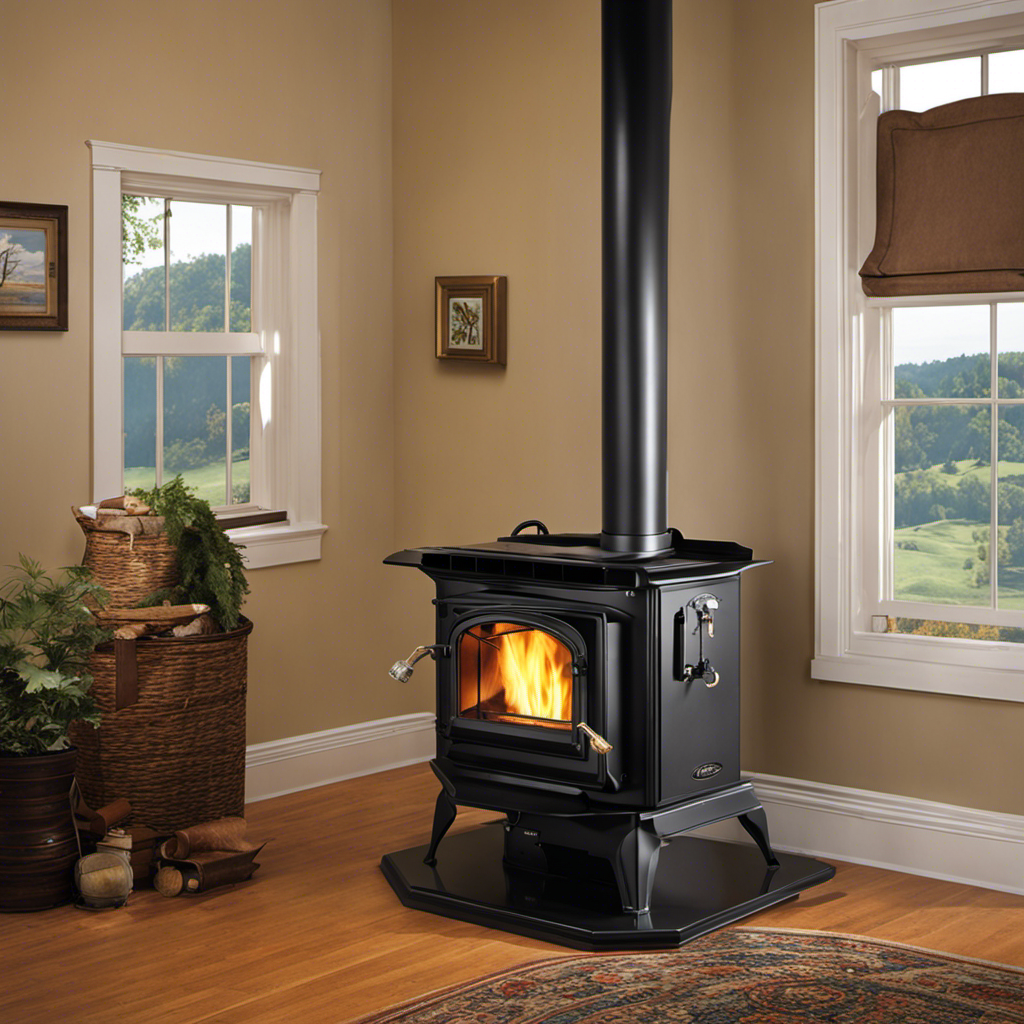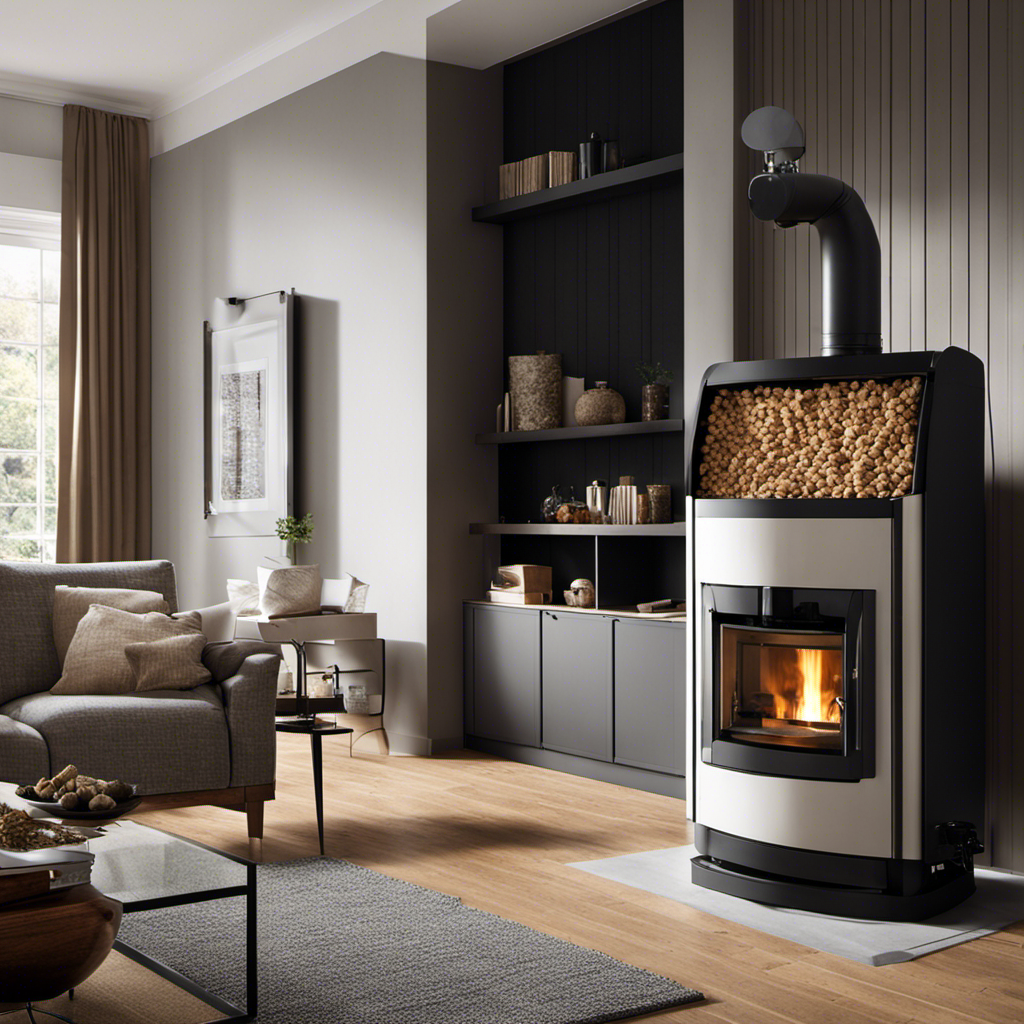While I may not see myself as an expert, I aim to share some insights about wood pellets.
These little wonders are made from compressed sawdust and other wood waste. They’re produced through a process called pelletizing, which involves drying and compressing the raw materials.
Wood pellets have become quite popular as a fuel source due to their many benefits. They’re used in a variety of applications, from heating homes to powering industrial boilers. And let’s not forget the environmental impact – wood pellets are a more sustainable option compared to other fuels.
So, if you’re considering wood pellets, there are some factors you should keep in mind.
Key Takeaways
- Wood pellets are made from compressed sawdust and other wood waste materials, offering a renewable energy source made from waste materials.
- Wood pellets have a high energy density, producing a lot of heat per unit of volume, and offer clean and efficient combustion, reducing emissions and contributing to a cleaner environment.
- Compared to other fuels, wood pellets have higher heating efficiency, lower carbon emissions, and are made from renewable resources, making them a cost-effective and sustainable choice for heating systems.
- When choosing wood pellets, it is important to consider factors such as the source of wood, certification of sustainability, production process, moisture content, ash content, sourcing and production, and packaging and transportation in order to minimize environmental impact and carbon footprint.
What Are Wood Pellets Made Of
Wood pellets are typically made of compressed sawdust or other wood waste materials. The wood pellet manufacturing process involves grinding the raw materials into small particles and then drying them to reduce the moisture content. The dried particles are then compressed under high pressure, using a pellet mill, to form the pellets.
The benefits of using wood pellets for heating are numerous. Firstly, they are a renewable energy source, as they are made from waste materials that would otherwise be discarded. Secondly, wood pellets have a high energy density, which means they produce a lot of heat per unit of volume. Additionally, they burn cleanly and efficiently, resulting in lower emissions and reduced environmental impact.
Now let’s delve into how wood pellets are produced, without further ado.
How Are Wood Pellets Produced
To produce wood pellets, you’ll need to start by collecting sawdust, shavings, or other wood byproducts. These raw materials are then processed through a series of steps using specialized equipment.
Let me explain the wood pellet production process and the equipment used in each step.
First, the collected wood byproducts are fed into a hammer mill, where they are pulverized into small particles. These particles are then dried to reduce the moisture content using a rotary dryer. The dried material is then fed into a pellet mill, which contains a die and rollers. As the material passes through the die, the heat and pressure generated by the rollers compress the particles, forming cylindrical wood pellets.
After the pellets are formed, they are cooled and screened to remove any fines or impurities. Finally, the finished wood pellets are packed into bags or stored in bulk for distribution.
Now that you understand the wood pellet production process and the equipment used, let’s explore the benefits of using wood pellets.
Benefits of Using Wood Pellets
If you’re looking for an environmentally-friendly alternative for heating, using wood pellets can reduce carbon emissions and contribute to sustainable energy sources.
Wood pellets are a form of renewable energy that is made from compacted sawdust or other wood waste. They are highly efficient for heating and cooking purposes, as they have a high calorific value and burn cleanly with minimal ash residue.
Wood pellets are produced using a process called pelletization, where the wood waste is compressed under high pressure to form small, dense pellets. These pellets can be easily transported and stored, making them convenient for residential and commercial use.
Wood pellets are versatile and can be used in various applications, such as pellet stoves, boilers, and even grills. They provide a reliable and sustainable source of heat and can significantly reduce the carbon footprint associated with traditional fossil fuel-based heating systems.
Wood Pellet Applications and Uses
Heating and cooking are two important applications of wood pellets, which are a renewable energy source.
Wood pellets can be used as a fuel for heating systems, such as pellet stoves and boilers, providing a reliable and efficient source of heat.
Additionally, wood pellets can be used for cooking in specialized pellet grills and ovens, offering a convenient and sustainable alternative to traditional cooking methods.
Heating and Cooking
Wood pellets are commonly used for both heating and cooking purposes. When it comes to heating efficiency, wood pellets are highly efficient due to their low moisture content and uniform size. This ensures that they burn cleanly and produce consistent heat output.
In terms of health benefits, wood pellets are a better option compared to traditional fossil fuels. They emit fewer pollutants, such as sulfur dioxide and carbon monoxide, which can be harmful to both human health and the environment. Additionally, wood pellets are made from renewable biomass, such as sawdust and wood chips, making them a sustainable and eco-friendly choice.
Transitioning into the subsequent section, wood pellets’ renewable nature positions them as a viable and environmentally friendly energy source.
Renewable Energy Source
Renewable energy sources, like wood pellets, are becoming increasingly popular due to their sustainability and eco-friendly properties. Wood pellets are a type of biomass fuel made from compressed sawdust, wood shavings, and other wood byproducts. They offer numerous benefits as a renewable energy source, including reduced greenhouse gas emissions and the ability to replace fossil fuels. Wood pellets are considered sustainable because they come from renewable resources and can be continuously produced. Additionally, using wood pellets for heating and cooking can help reduce dependence on non-renewable energy sources and contribute to a cleaner environment.
| Renewable Energy Benefits | Sustainability Advantages |
|---|---|
| Reduced greenhouse gas emissions | Renewable resource |
| Can replace fossil fuels | Continuous production |
| Reduces dependence on non-renewable energy sources | Cleaner environment |
Comparing wood pellets to other fuel sources, it is important to evaluate their cost-effectiveness, efficiency, and environmental impact.
Comparing Wood Pellets to Other Fuel Sources
Comparing wood pellets to other fuel sources, it’s clear that they offer a more sustainable option for energy consumption. Wood pellets have higher heating efficiency compared to traditional fossil fuels like coal or oil. This means that they can produce more heat with less waste, making them a cost-effective choice for heating systems.
Additionally, wood pellets have significantly lower carbon emissions compared to fossil fuels. This is because wood pellets are made from compressed sawdust and other wood waste, which are renewable resources, whereas fossil fuels release carbon dioxide when burned. By using wood pellets, we can reduce our carbon footprint and contribute to a cleaner environment.
- Wood pellets have higher heating efficiency
- Produce more heat with less waste
- Cost-effective for heating systems
- Wood pellets have lower carbon emissions
- Made from renewable resources
- Reduce carbon footprint
Considering the environmental impact of wood pellets, it is important to analyze their production process and potential effects on ecosystems.
Environmental Impact of Wood Pellets
When considering the environmental impact of wood pellets, it’s crucial to examine their production process and potential effects on ecosystems. Wood pellets are often touted as a sustainable and renewable form of energy, but it is important to understand the full picture. The production of wood pellets involves the harvesting and processing of wood, which can contribute to deforestation if not managed properly. This has a significant impact on ecosystems, as it disrupts habitats and reduces biodiversity. Additionally, the carbon footprint of wood pellets must be taken into account. While burning wood pellets releases carbon dioxide, it can be considered carbon neutral if the trees used for production are replanted. However, if large-scale deforestation occurs, the carbon emissions can outweigh the benefits. Therefore, it is crucial to carefully consider the source and production methods when choosing wood pellets as a fuel source.
| Factors to Consider When Choosing Wood Pellets |
|---|
| Source of wood |
| Certification of sustainability |
| Production process |
| Carbon footprint |
| Environmental impact |
Considering these factors will help ensure that the wood pellets chosen have a minimal environmental impact and promote sustainability.
Factors to Consider When Choosing Wood Pellets
When considering which wood pellets to choose, there are several important factors to take into account.
The first is the balance between quality and price. While it may be tempting to opt for the cheapest option, it is crucial to ensure that the pellets meet the necessary quality standards to effectively fuel your heating system.
Additionally, the environmental impact of the wood pellets should be carefully considered, as using sustainably sourced pellets can significantly reduce carbon emissions.
Lastly, availability and sourcing are key factors to consider, as it is important to choose pellets that are readily available and sourced from a reliable and responsible supplier.
Quality Vs. Price
If you’re looking for the best value, you’ll need to weigh the quality against the price of wood pellets. When it comes to wood pellets, the quality and price are interconnected, and finding the right balance is crucial.
Here are some factors to consider:
-
Quality:
-
Moisture content: Opt for wood pellets with low moisture content, as it ensures efficient combustion and reduces waste.
-
Ash content: Lower ash content means less maintenance and cleaner burn.
-
Price:
-
Sourcing and production: Wood pellets made from sustainably sourced materials may come at a higher price, but they contribute to environmental preservation.
-
Packaging and transportation: Consider pellets packaged in eco-friendly materials and produced locally to minimize carbon footprint.
Finding a balance between quality and price is key to achieving sustainability vs. affordability.
Now, let’s delve into the environmental impact of wood pellets.
Environmental Impact
Considering the environmental impact, it’s important to choose sustainably sourced materials for a lower carbon footprint. When it comes to wood pellets, the choice of raw materials plays a crucial role in determining their environmental impact. One of the main concerns is deforestation, which contributes to increased carbon dioxide levels and loss of biodiversity. By using sustainably sourced materials, such as wood from responsibly managed forests or agricultural residues, we can minimize the carbon footprint associated with wood pellet production.
To better understand the environmental impact of different wood pellet materials, let’s take a look at the following table:
| Raw Material | Environmental Impact |
|---|---|
| Virgin wood | High |
| Residues | Moderate |
| Waste wood | Low |
| Non-woody biomass | Low |
As we can see, using waste wood or non-woody biomass as raw materials for wood pellets significantly reduces their environmental impact. This highlights the importance of choosing the right materials to minimize our carbon footprint and contribute to sustainable practices.
Transitioning into the subsequent section about availability and sourcing, let’s explore the various options for obtaining these sustainable wood pellet materials.
Availability and Sourcing
Sustainably sourced materials for wood pellets can be obtained from responsibly managed forests or agricultural residues. When it comes to availability challenges, the main issue arises from the limited supply of responsibly managed forests. However, there are alternative sources of sustainable wood pellets, such as agricultural residues, which can help alleviate this problem.
To ensure sustainable sourcing, it is important to consider the following:
-
Forest Management: Responsible forest management practices, such as selective logging and reforestation, can help maintain the availability of wood resources for pellet production.
-
Agricultural Residues: Utilizing agricultural residues, such as crop stalks or straw, can provide an additional source of biomass for wood pellet production, reducing the strain on forests.
Frequently Asked Questions
Are Wood Pellets Safe to Use in Residential Heating Systems?
Yes, wood pellets are safe to use in residential heating systems. They have a lower environmental impact compared to traditional fuels and are efficient and effective as a heating source.
Can Wood Pellets Be Used in Cooking and Grilling?
Yes, wood pellets can be used for cooking and grilling. They provide a smoky flavor to the food and can be used in pellet grills or smokers. Wood pellets are a convenient and efficient option for outdoor cooking enthusiasts.
Are Wood Pellets More Expensive Than Other Traditional Fuel Sources?
Wood pellets are not more expensive than other traditional fuel sources. In fact, they can be cost-effective due to their efficient production process. Additionally, wood pellets have a lower environmental impact compared to fossil fuels.
Can Wood Pellets Be Used in Industrial Processes?
Yes, wood pellets can be used in industrial processes. Their environmental impact is lower than traditional fuels, and they are efficient in industrial heating systems. They are a sustainable and cost-effective option for many industries.
What Types of Wood Are Commonly Used to Make Wood Pellets?
Common types of wood used for wood pellets include hardwoods like oak and maple, and softwoods like pine and fir. Using wood pellets for heating offers benefits such as high energy density and low emissions.
Can Wood Pellet Rifles Cause Harm or Injury?
Wood pellet rifles shooting power can definitely cause harm or injury if not used properly. These rifles are not toys and should be handled with caution. It is important to always follow safety guidelines and ensure that the appropriate safety measures are in place when using wood pellet rifles.
Conclusion
In conclusion, wood pellets are a highly efficient and sustainable fuel source that offer numerous benefits.
While some may argue that wood pellets have a higher upfront cost compared to traditional fuels, it is important to consider the long-term savings and environmental advantages they provide.
By choosing wood pellets, individuals can contribute to reducing carbon emissions and promoting a greener future.
With their versatility and wide range of applications, wood pellets are a smart choice for heating, cooking, and powering various industries.
So why not join the wood pellet revolution and make a positive impact on our planet?
Logan’s affair with adventure began in childhood. He hailed from a small town where vast forests bordered one side and endless shores stretched on the other. His days were spent exploring uncharted woods, climbing tall trees, or listening to the tales of old sailors. This early immersion in a world brimming with stories and mysteries became the foundation of his passion for writing.











